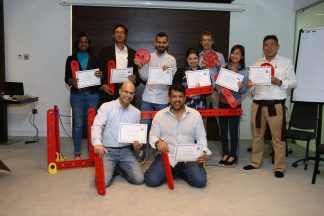9 Steps to Successful Experiential Learning
There is one basic rule and 9 simple practical steps that can help even the least experienced facilitator develop the learning.
The Rule: Successful experiential learning demands that participants are engaged in the learning process and think for themselves: you can guide them but you must not think for them.
9 Practical Steps to Successful Experiential Learning
1. Choose a task that takes into account participants’ current skills and behaviours and the required learning outcomes.
The task: This should be stimulating and inclusive, will often include a fun element, should take the minimum amount of time to provide the learning opportunities, and, from a facilitator’s view point, be easy to administer.
2. Keep the required learning outcomes in your mind in the planning process and during the activity.
3. Plan how you intend to develop the learning before participants start the task, but be prepared to adapt to changing circumstances.
The learning process: This must be engaging, non-threatening, personally relevant and enlightening. Expect facilitating the learning process to take much more time than the task, and be personally demanding: when done well is not easy for anyone, even the most able and experienced.
4. With groups who are new to experiential learning lead a plenary discussion immediately after the first task. The best question I know for use in this plenary discussion is:
‘If I were to ask you to do a similar activity again, what are the key skills, abilities, attitudes, approaches and behaviours that would enable you to be as successful as possible if you were to tackle a similar task again?’
Repeat the question over and over, encouraging everyone to contribute. Probe for details, e.g. if an answer is ‘communication’ ask ‘what aspects of communication would be helpful?’ Note every answer onto a flip chart. Expect 20 – 40 answers before asking them to think and highlight individually which of the points they did well and note where they have clear scope for improvement. Return to small groups to discuss their notes before activity 2.
5. With more experienced people run self-managed groups: provide worksheets with either:
Open-ended questions that target the key learning objectives, e.g. ‘Describe how your group planned your approach’. Ensure that everyone works through their worksheets on their own before any discussion between group members. Ask the groups to discuss everyone’s answers with the aim of identifying what went well, where they have scope for improvement and what should be done by whom. Or use tick box worksheets highlighting a whole list of criteria, e.g. ‘I listen well’, ‘I asked lots of questions’, ‘I gave my views freely, I was too quiet’. This approach focuses thinking and provides a quick way to raise issues, but it can lead to superficial responses.
6. Ensure that you do not become the focus of the discussions, lead the thinking or take control: make sure individuals think for themselves by continually asking open questions that lead on from what group members are saying. You are there to facilitate, not to teach.
7. Get the group to summarise their learning and ensure that everyone has points that they want to try out or put into practice in subsequent activities.
8. Never tell people what they should have learned or what you wanted them to learn, just monitor their progress and plan your actions and subsequent activities accordingly.
9. Believe in people: they will learn if you work with them to create an appropriate learning environment.
There are two key elements to experiential learning; the task; and the learning process.
The task: This should be stimulating and inclusive, will often include a fun element, should take the minimum amount of time to provide the learning opportunities, and, from a facilitator’s view point, be easy to administer.
The learning process: This must be engaging, non-threatening, personally relevant and enlightening. Expect facilitating the learning process to take much more time than the task, and be personally demanding: when done well is not easy for anyone, even the most able and experienced.
Why do things sometimes go wrong?
It’s often because the tasks (games) can be engaging, fun, and are easy to run, they are often used as ‘enter-train-ment!’. When used in this way they are a waste of everyone’s time and give experiential learning a bad name.
Making things go right
Follow the one basic rule and these 9 simple practical steps to develop the learning.
If you have any more questions about experiential learning or how to plan a workshop please get in touch!

